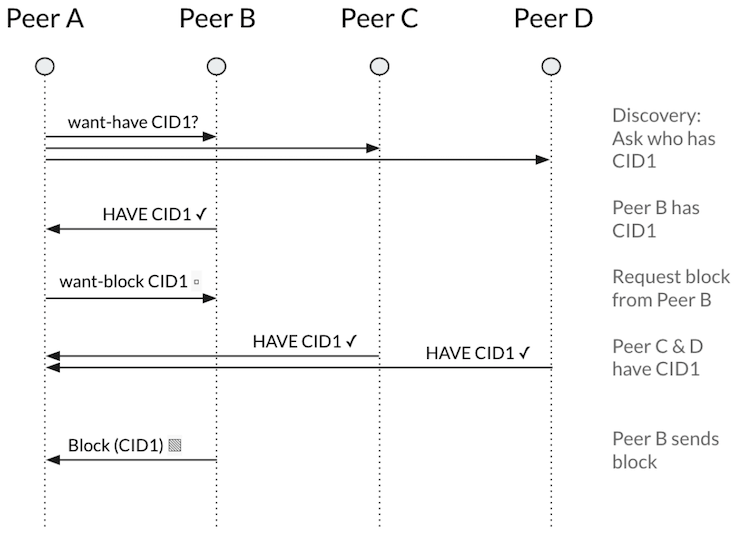# Bitswap
Bitswap is a core module of IPFS for exchanging blocks of data. It directs the requesting and sending of blocks to and from other peers in the network. Bitswap is a message-based protocol where all messages contain want-lists or blocks. Bitswap has a Go implementation (opens new window) and a JavaScript implementation (opens new window).
Bitswap has two main jobs:
- Acquire blocks requested by the client from the network.
- Send blocks in its possession to other peers who want them.
# How Bitswap works
IPFS breaks up files into chunks of data called blocks. These blocks are identified by a content identifier (CID). When nodes running the Bitswap protocol want to fetch a file, they send out want-lists to other peers. A want-list is a list of CIDs for blocks a peer wants to receive. Each node remembers which blocks its peers want. Each time a node receives a block, it checks if any of its peers want the block and sends it to them if they do.
Here is a simplifed version of a want-list:
Want-list {
QmZtmD2qt6fJot32nabSP3CUjicnypEBz7bHVDhPQt9aAy, WANT,
QmTudJSaoKxtbEnTddJ9vh8hbN84ZLVvD5pNpUaSbxwGoa, WANT,
...
}
# Discovery
To find peers that have a file, a node running the Bitswap protocol first sends a request called a want-have to all the peers it is connected to. This want-have request contains the CID of the root block of the file (the root block is at the top of the DAG of blocks that make up the file). Peers that have the root block send a have response and are added to a session. Peers that don't have the block send a dont-have response. If none of the peers have the root block, Bitswap queries the Distributed Hash Table (DHT) to ask who can provide the root block.

# Transfer
Once peers have been added to a session, for each block that the client wants, Bitswap sends want-have to each session peer to find out which peers have the block. Peers respond with have or dont_have. Bitswap builds up a map of which nodes have and don't have each block. Bitswap sends want-block to peers that have the block, and they respond with the block itself. If no peers have the block, Bitswap queries the DHT to find providers who have the block.
# Additional references
- February 2020: New improvements to IPFS Bitswap (opens new window)
- Technical overview of the Go implementation of Bitswap (opens new window)
- Article: Swapping bits and distributing hashes on the decentralized web (Textile) (opens new window)
- "About Bitswap" Go implementation poster from the IPFS developer summit in Berlin in July 2018:

